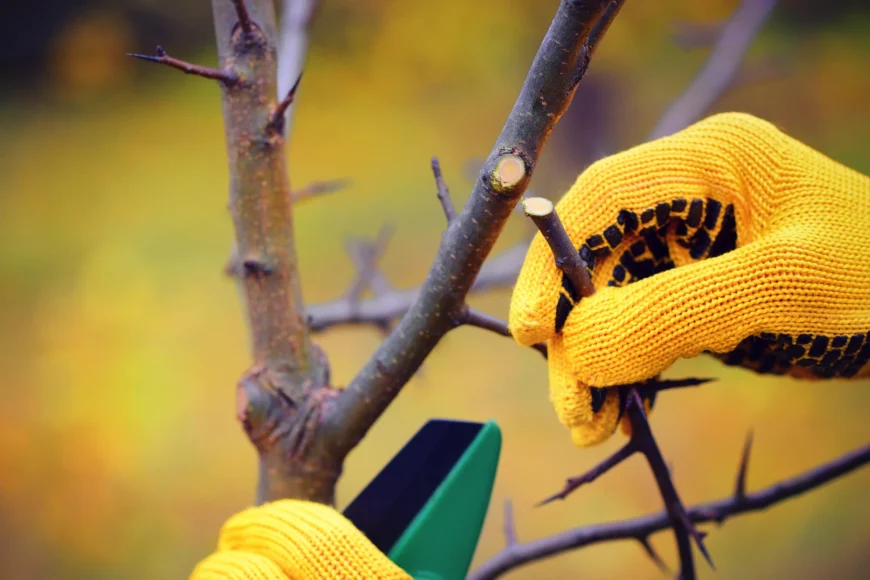Pruning your trees is an important step in maintaining their health, but it can be tricky to know when the best time is and how to do it properly. With this seasonal guide, you’ll learn all the tips and tricks necessary for proper tree care so you can prune like a pro in no time!
Understanding the Benefits of Pruning
Pruning your trees every season is a beneficial practice as it helps remove dead wood, encourages new growth and promotes a healthier tree structure. This process can improve the aesthetics of your garden, allow air and light to reach the center of the tree more easily, and make your trees less inviting for pests and other damaging organisms. Additionally, pruning can help keep people safe by reducing the size of large branches that might be dangerous in high winds or heavy rains.
The best time of year to prune your trees depends on the species, but generally, it’s best to prune in late fall, winter and early spring. During these times, most trees are dormant and no longer actively growing. Pruning during dormancy helps reduce the risk of shock or infection because there are fewer pests and diseases active in colder weather. It’s also easier to make drastic cuts when a tree is not actively producing leaves and new growth. Aim to prune your trees before bud break or flowering begins in late winter or early spring.
Pruning your trees during dormancy ties in to their natural growth cycle. Because trees are not actively growing, it’s easier to adjust their shape and size. In addition, pruning gives you a better perspective on the overall structure of the tree and allows you to identify dead or diseased branches. As an added bonus, pruning at this time of year also helps discourage new pests from infesting the tree due to less activity among insects in winter.
Gear Up with The Right Tools
When you’re ready to prune, make sure you have the proper equipment. For light pruning or dead heading, hand pruners may do the trick. For larger limbs or branches, you’ll need lopping shears or a hand saw for larger trees. Make sure you use sharp and clean tools to prevent spreading any diseases from one tree to another and disinfect your equipment each time you start pruning a new tree. Properly caring for your tools will also ensure a cleaner cut on the tree.
Smaller tools, such as pruning shears, can be used for thinning out dense branches, while bigger tools such as loppers are best left to heavier pruning. Sterilize pruning tools before and after each use in order to avoid spreading any diseases to the tree. Prune your tree only when needed and never remove more than one-third of the plant’s foliage at a time. Different trees and shrubs have different pruning needs so research what type of tree you have for specific guidelines on the timing and techniques for effective pruning.
Time and Techniques for Pruning in Spring
Pruning with the right timing and techniques is essential for establishing healthy trees. Springtime is an ideal season to prune most deciduous trees in order to create strong, attractive branches that won’t be damaged by weight or strong winds. Prune away deadwood, any crossed or rubbing branches, and any weak limbs. Remember that growth hormones are concentrated at the tips of a tree’s branches so don’t leave stubs when pruning; instead make cuts as close to the collar as possible for more rapid wound healing.
Spring is also the best time to prune fruit trees to encourage strong, healthy growth and higher yields. When pruning any fruit tree, focus on developing a strong framework of limbs during the first few years of the tree’s life. In the years that follow, keep in mind that fruit production occurs on spurs and shoots that grow out from these main framework branches. Then, make sure to cut back longer branches so light reaches all parts of the tree and sunlight can properly ripen its fruits.
Generally speaking, however, pruning should take place during colder months when trees are still in their dormant stages. This will ensure that you do not inadvertently harm new or existing growth. During this period, start by removing dead or diseased branches as soon as they appear, but also look for crossed, damaged, cracked or rubbing branches that could cause problems later on down the line. In addition, remove any limbs growing too closely together and those that are heading towards nearby buildings or power lines.
Ask the Experts at Thomas Greenhouse & Gardens
We can help! Ask our team for tips and tricks for pruning your trees this spring. Learn more about deciduous trees, evergreen trees, and ornamental trees for your yard.
About Thomas Greenhouse & Gardens
We grow our plants and flowers in our greenhouse. Our garden experts tend to them from seed to bloom with love and care. That means that our plants are strong, healthy and ready to be planted in your garden. Thomas Greenhouse & Gardens is the best choice for plants, annual flowers, perennial flowers, shrubs and trees near Mukwonago, Burlington, Lake Geneva and Waukesha.


